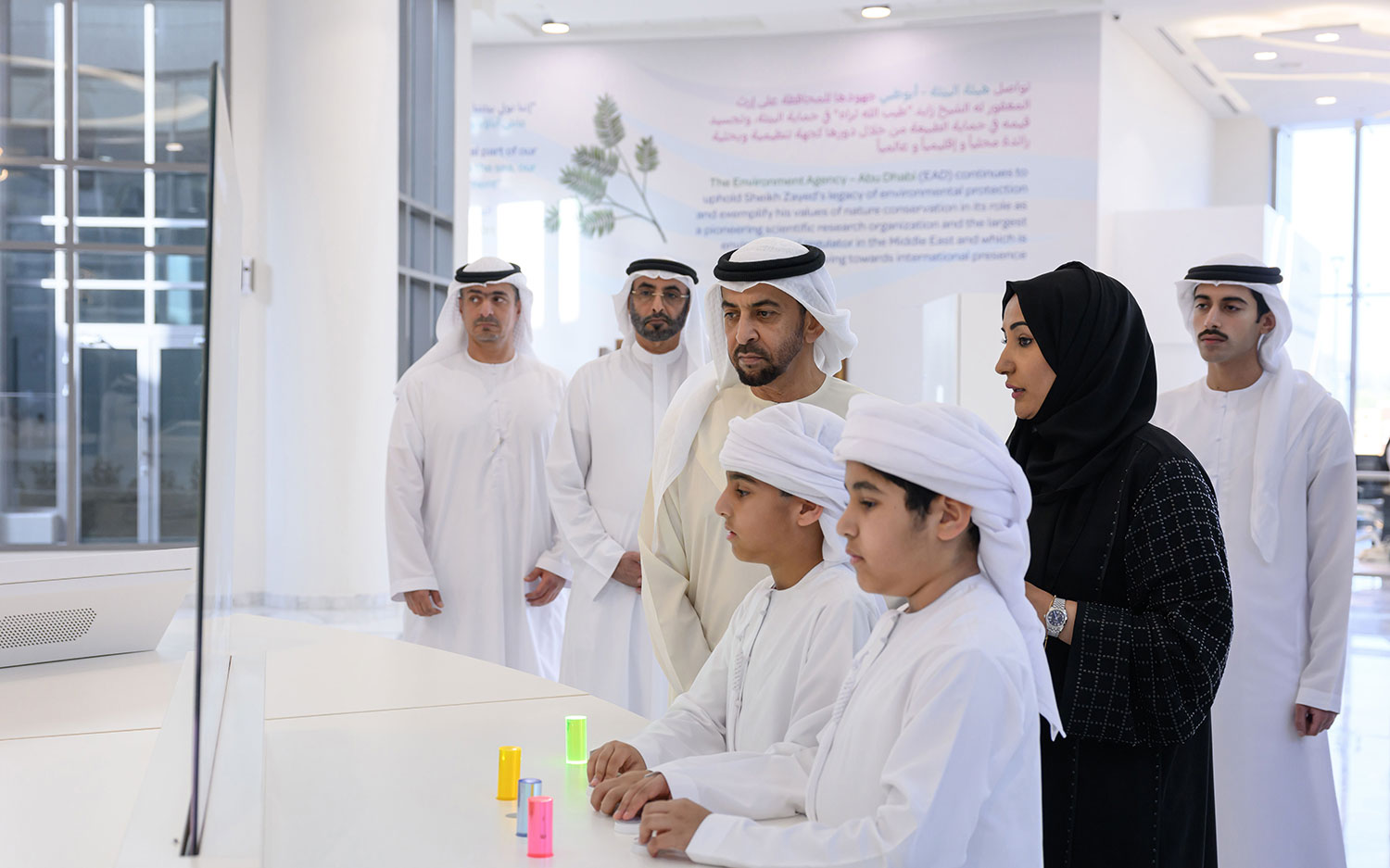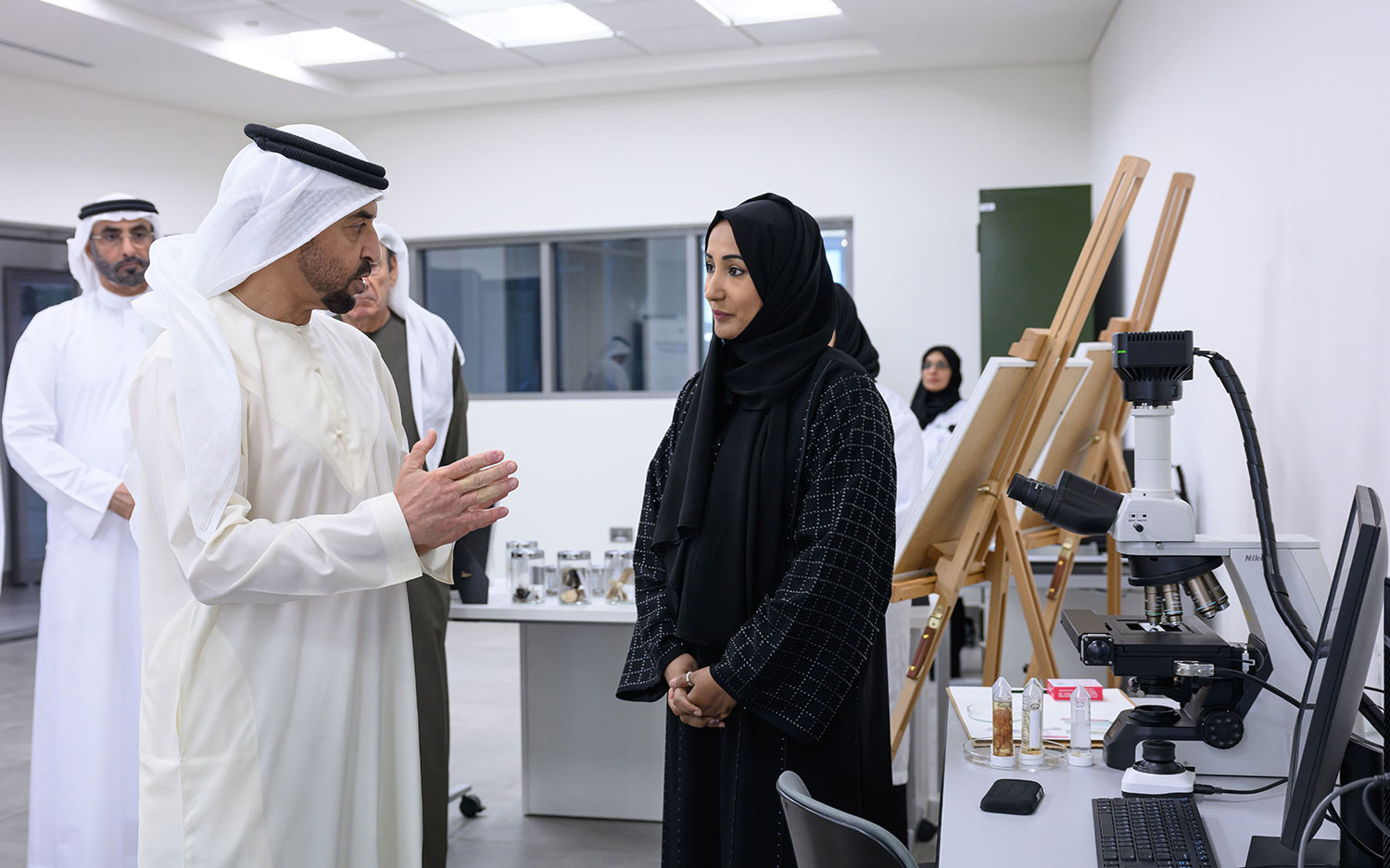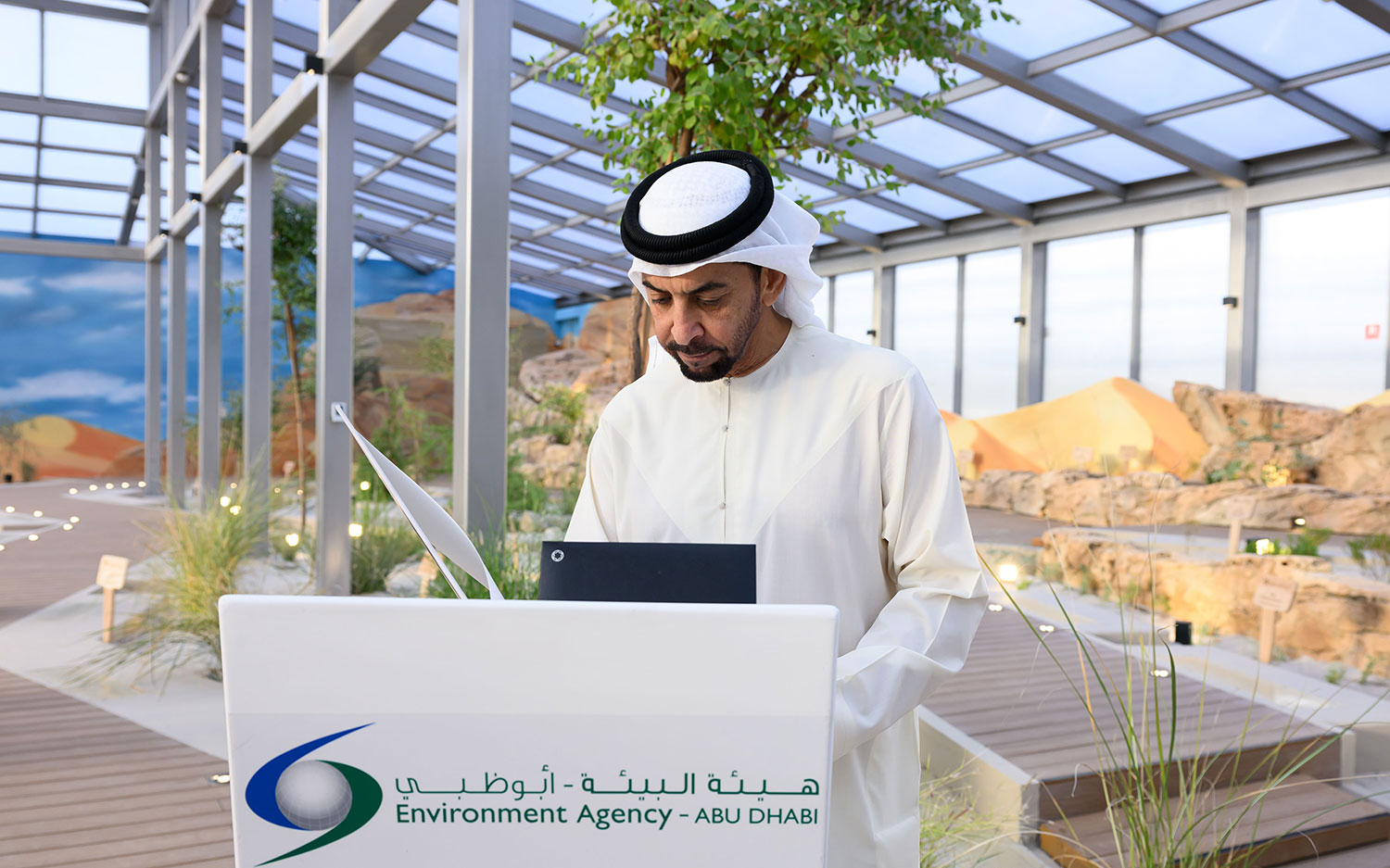H.H. Sheikh Hamdan bin Zayed Al Nahyan, Ruler's Representative in the Al Dhafra Region and Chairman of the Board of Directors of the Environment Agency – Abu Dhabi (EAD), inaugurated the Plant Genetic Resources Centre established by the Agency in Al Ain City. Considered the region’s first such centre of its kind, it aims to ensure the preservation of seeds and tissues of all wild plant types and local agricultural species of importance in the UAE.













The inauguration was attended by Sheikh Yas bin Hamdan bin Zayed Al Nahyan; Mohammed Ahmed Al Bowardi, EAD’s Vice Chairman of the Board of Directors; Zaki Anwar Nusseibeh, Cultural Advisor to His Highness the President of the UAE and Chancellor of the UAE University; and Ahmed Matar Al Dhaheri, Director of the Office of the Ruler's Representative in the Al Dhafra Region; Engineer Ali Khalifa Al Qamzi, Director General of the Municipality of Al Ain City; Dr. Shaikha Salem Al Dhaheri, EAD’s Secretary General, and a number of officials.
H.H. Sheikh Hamdan bin Zayed Al Nahyan began his visit to the centre by inspecting the display and education area, which aims to inform visitors of all ages and researchers on the importance of the country’s local plant species and associated preservation methods. The display area contains 10 different interactive experiences, developed in cooperation with leading international companies and displayed in innovative ways never before seen.
Sheikh Hamdan visited the Seed Processing and Testing Laboratory, the first stop for the various external samples of wild plants and seeds arriving at the centre, and which conducts an array of tests on the seeds to ensure their vitality and suitability for storage and use in propagation and cultivation processes. The laboratory is equipped with eight cutting-edge devices, which use world-first, state-of-the-art technologies.
H.H. also visited the herbarium for the classification and scanning of wild plant samples. The facility will ensure the accurate scientific classification of all plants, and their documentation in the form of dried samples as well as electronic digital samples for inclusion into the Agency’s database. This will enable local and international researchers to both view and use the samples in their various research projects. The herbarium currently contains more than 4,000 dried specimens and 2,666 digital specimens.
H.H. was also briefed on the centre’s various preservation methods, such as its cooling rooms as well as the use of liquid nitrogen to preserve samples at temperatures down to -196 degrees Celsius. These methods ensure the preservation of samples for long-term periods – up to more than 100 years.
H. H.’s tour included an inspection of the wild plants genetic sequencing laboratory, which is equipped with the world’s most advanced equipment to study and characterise wild plant genomes to help ensure their preservation and study their fertility. The lab also uses those plants and characteristics to conserve and rehabilite habitats, helping to raise the productivity of vegetation, combat the effects of climate change, and identify shapes of different types.
H. H.also visited the greenhouse and its representation of five basic natural habitats of the United Arab Emirates: coastal habitats, sand sheets, sand dunes, valleys, and mountains. More than 50 local plant species native to these distinct environments have been grown, and provide visitors with a rich educational and cultural experience. The greenhouse will also be used to propagate some plant species outside of the regular agricultural seasons, as it provides suitable conditions for germination and growth, with temperatures, humidity, and lighting all carefully controlled. Various types of soil are also used to create the ideal atmosphere for the plants’ long-term growth.
On the occasion of his visit, Sheikh Hamdan, said: “The establishment of the centre coincides with the Year of Sustainability and falls under the umbrella of EAD’s efforts to protect local wild plant species in Abu Dhabi and the rest of the emirates.”
He pointed out that the Agency, since its establishment, has worked to preserve local plants within their naturalhabitats by establishing a network of natural reserves and by issuing a laws and legislation to protect various wild species – including plants. These efforts are aligned with the ambitious vision of Abu Dhabi, linked to both the implementation of the National Biodiversity Strategy and the state’s action plan to ensure the preservation and sustainability of biological diversity.
Sheikh Hamdan stressed that EAD continues to preserve the legacy of the late Sheikh Zayed in protecting the environment, and embody his nature conservation values through its role as a leading regulatory and research body locally, regionally, and globally.
He also highlighted the importance of the centre’s role in documenting the genetic sources and diversity of local plants and preserving important species and their genetic characteristics. The centre’s integrated approach includes internal and external preservation methods for the various plant types to preserve biodiversity in the UAE and the region, and to re-cultivate and propagate them in nature, while protecting endangered species.
H.H. also mentioned the centre’s important role in enhancing vegetation cover and rehabilitating degraded natural habitats, boosting Abu Dhabi’s global environmental leadership status and its pioneering role in the field of sustainable development. The Plant Genetics Resources Centre will also contribute to building the technical, scientific and administrative capabilities of specialised local cadres. In addition to its role as a research and education hub for the country’s university students, it is the first centre of its kind in the region to conduct research related to the preservation and sustainability of plant biodiversity.
Dr. Shaikha Salem Al Dhaheri, Secretary General of EAD, confirmed: “The Plant Genetic Resources Centre will play an essential role in preserving natural plants, ensuring the preservation of seeds in order to ensure a long-term sustainable future for upcoming generations.
She added that the centre includes a site specialised in the collection and long-term preservation of wild local plant seeds for periods of up to 100 years, which will be collected from all over the country and stored within refrigerated rooms at temperatures of -20 degrees Celsius. There will also be laboratories specialised in plant tissue culture operations, the deep preservation of vegetative parts and tissues at temperatures of -196 degrees Celsius, and a specialised laboratory for conducting genomic sequencing of wild plants. These facilities will play an important role in plant conservation efforts, by helping specialists understand plant species, their genetic diversity, and their ability to adapt to environmental conditions.
Dr. Al Dhaheri stated that the centre includes a herbarium for various plant samples collected and dried from various regions of the country, which will be classified and physically archived. Digital samples will also be stored within a specialised EAD database that will help local and international researchers to view the samples and classify plants.
Dr. Al Dhaheri added that the centre also includes a specialised exhibition aimed at enriching visitors’ experiences and boosting their knowledge about the importance of local plants. Visitors can enjoy more than 10 different experiences, with each one displaying associated information on the latest methods being used. The centre’s glass house will represent various natural habitats and their distinctive wild plants, allowing visitors to view them and learn more about the plants and their natural habitats. The building’s external landscaping represents a mini botanical experience in which the most important local plants and information on their various uses are displayed, which will also play a major role in building visitors’ understanding and knowledge.
During the project’s various design stages and studies, EAD cooperated with many local and international bodies and institutions, including the Ministry of Climate Change and Environment (MOCCAE), Abu Dhabi Agriculture and Food Safety Authority, (ADAFSA), the Environment and Protected Areas Authority – Sharjah, Al Dhafra Region Municipality, Al Ain Municipality, United Arab Emirates University, the International Center for Biosaline Agriculture (ICBA), the Royal Botanical Garden - KEW and the Millennium Seed Bank – UK. The Agency will continue to build effective partnerships that facilitate the exchange of knowledge, ideas and resources to support scientific discoveries and innovative solutions.
The Agency’s continuous efforts to rehabilitate vegetation cover has been enhanced through the establishment of the Sheikh Zayed Protected Areas Network, with its 13 terrestrial protected areas covering different natural habitats. The improvement of natural cover has been observed thanks to enhanced protection measures and the mitigation of risks, such as overgrazing. EAD is also constantly working to increase the area of existing wildlife reserves or create new ones that play a fundamental role in protecting various forms of natural vegetation and ensuring its development. This will gradually benefit various groups of small and medium-sized wildlife as both a source of food or natural shelter.
In 2010, EAD established a private nursery in the Al Dhafra region, with an annual production capacity of 500,000 seeds from approximately 68 local plant species. The seedlings produced are used in wild habitat rehabilitation projects implemented by the Agency and its partners. For use in various other projects, the Agency has also established a group to preserve and sustain wild plant seeds from more than 70 species, collected from a range of natural habitats.
EAD has made several attempts to rehabilitate a number of wild habitats, successfully planting and rehabiliting areas with their distinctive native plants, such as Acacia and White Saxaul shrubs, in both Al Ghada Protected Area and Jebel Hafeet National Park. There is a recurring annual plan to continue seed dispersal for local plants within natural habitats, as well as the use of modern technology such as seed dispersal by drones and the use of subsurface irrigation systems that regulate water use. Every year, at least one million seeds from various wild plants will be scattered throughout all the reserves, with the aim of enriching the soil’s natural seed content and increasing natural vegetation cover.
Regarding the Plant Genetic Resources Centre’s sustainability aspects, it has been awarded a Pearl 2 rating within the Abu Dhabi Local Building Sustainability System All the centre’s car shades are covered with solar cells, and produce electrical energy to cover more than 30 per cent of the centre's needs. The building’s exterior cladding was made using terracotta from natural materials, which activates the thermal insulation of the building, reducing electricity consumption. Natural lighting was used in some offices and laboratories by featuring skylights, saving electricity consumption. Local plants were used as part of the landscaping around the centre, which reduces irrigation water consumption, and the site’s Ghaf trees were preserved by incorporating them into the landscaping designs. Non-reflective colours and dyes are used to ensure no visual impact on migratory birds during the two avian migration seasons.
